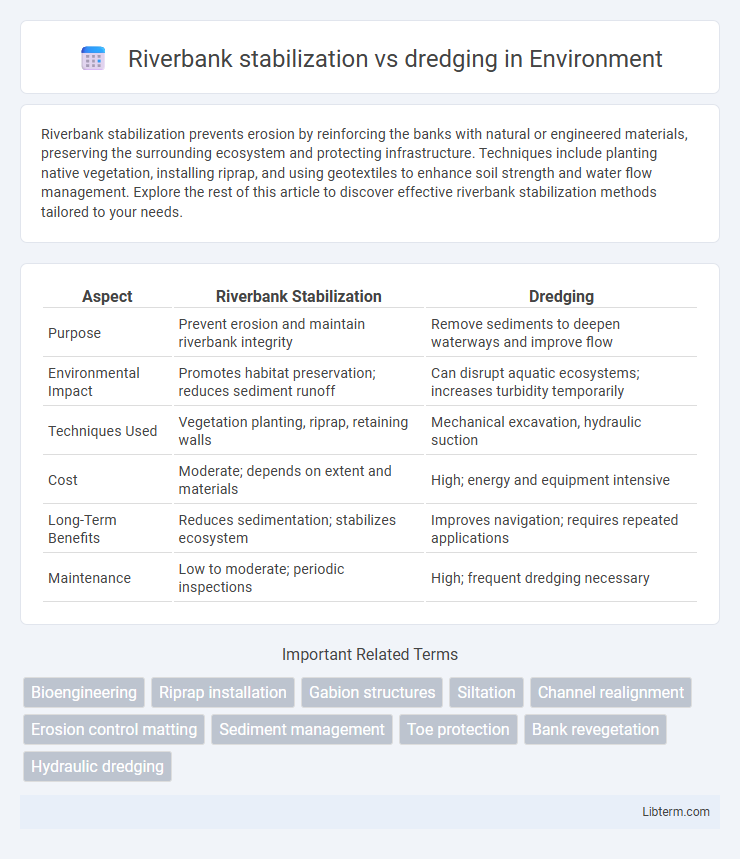Riverbank stabilization prevents erosion by reinforcing the banks with natural or engineered materials, preserving the surrounding ecosystem and protecting infrastructure. Techniques include planting native vegetation, installing riprap, and using geotextiles to enhance soil strength and water flow management. Explore the rest of this article to discover effective riverbank stabilization methods tailored to your needs.
Table of Comparison
| Aspect | Riverbank Stabilization | Dredging |
|---|---|---|
| Purpose | Prevent erosion and maintain riverbank integrity | Remove sediments to deepen waterways and improve flow |
| Environmental Impact | Promotes habitat preservation; reduces sediment runoff | Can disrupt aquatic ecosystems; increases turbidity temporarily |
| Techniques Used | Vegetation planting, riprap, retaining walls | Mechanical excavation, hydraulic suction |
| Cost | Moderate; depends on extent and materials | High; energy and equipment intensive |
| Long-Term Benefits | Reduces sedimentation; stabilizes ecosystem | Improves navigation; requires repeated applications |
| Maintenance | Low to moderate; periodic inspections | High; frequent dredging necessary |
Introduction to Riverbank Erosion Challenges
Riverbank erosion poses significant threats to infrastructure, ecosystems, and water quality, necessitating effective management strategies. Riverbank stabilization techniques, including vegetation planting and structural reinforcements, aim to prevent soil loss and maintain bank integrity. Dredging, while primarily used to deepen waterways, can exacerbate erosion by altering natural sediment transport and flow dynamics, making it a less sustainable solution for erosion control.
Understanding Riverbank Stabilization
Riverbank stabilization involves reinforcing riverbanks using vegetation, riprap, or engineered structures to prevent erosion and maintain water quality. Compared to dredging, which removes sediment to deepen waterways, stabilization focuses on preserving habitat and reducing sediment runoff naturally. Effective riverbank stabilization supports ecosystem health and long-term river management by enhancing soil retention and minimizing disruptive interventions.
What is River Dredging?
River dredging involves the removal of sediments, debris, and accumulated materials from the riverbed to maintain or increase water depth and improve navigation, flood control, and ecosystem health. This process contrasts with riverbank stabilization, which focuses on reinforcing the shores to prevent erosion and maintain structural integrity. Effective dredging requires careful management to minimize environmental disruption while achieving targeted water flow and sediment balance.
Causes of Riverbank Instability
Riverbank instability is primarily caused by soil erosion, fluctuating water levels, and human activities such as construction and deforestation that weaken the banks. Sediment transport and hydraulic forces during floods accelerate undermining of riverbanks, leading to collapse and loss of vegetation. Riverbank stabilization techniques address these causes by reinforcing bank structure and controlling erosion, while dredging mainly removes sediment to maintain navigable channels but does not directly stabilize banks.
Benefits of Riverbank Stabilization
Riverbank stabilization enhances ecosystem health by preventing soil erosion, which preserves aquatic habitats and maintains water quality. This method reduces sedimentation in waterways, lowering the risk of downstream flooding and protecting infrastructure. Compared to dredging, riverbank stabilization offers long-term environmental sustainability and cost-effective erosion control.
Advantages of Dredging for Waterways
Dredging enhances waterway navigation by removing sediment buildup, increasing channel depth, and preventing flooding. It improves water quality by eliminating contaminated sediments and promoting better aquatic habitats. This method supports infrastructure maintenance, facilitates commercial shipping, and reduces erosion risks along riverbanks.
Environmental Impacts: Stabilization vs Dredging
Riverbank stabilization minimizes soil erosion and protects aquatic habitats by reinforcing natural vegetation and structures, thereby preserving water quality and biodiversity. In contrast, dredging disrupts sediment layers, potentially releasing pollutants, increasing turbidity, and disturbing aquatic ecosystems. While stabilization promotes long-term ecological balance, dredging often leads to habitat destruction and altered water flow, resulting in significant environmental impacts.
Cost Comparison: Stabilization vs Dredging
Riverbank stabilization typically incurs lower long-term costs compared to dredging due to reduced maintenance and prevention of erosion-related damage. Dredging involves higher initial expenses and recurring costs for sediment removal and equipment operation, often exceeding the budget allocated for stabilization projects. Investing in stabilization methods like riprap or vegetation can offer cost-effective, sustainable solutions that minimize the frequent financial burdens associated with dredging.
Long-Term Effectiveness of Each Approach
Riverbank stabilization offers long-term erosion control by reinforcing soil and vegetation, reducing sediment runoff and preserving ecosystem health. Dredging temporarily improves water depth and flow but often requires repeated interventions due to sediment accumulation and potential habitat disruption. Sustainable river management favors stabilization techniques for enduring shoreline integrity and aquatic system balance.
Factors to Consider When Choosing a River Management Method
Riverbank stabilization requires evaluating soil type, vegetation, and erosion rates, while dredging demands assessment of sediment composition, water depth, and aquatic ecosystem impact. Cost-effectiveness, long-term sustainability, and regulatory compliance also influence the choice between stabilizing riverbanks or dredging. Effective river management hinges on balancing environmental preservation with flood control and navigation needs.
Riverbank stabilization Infographic

 libterm.com
libterm.com